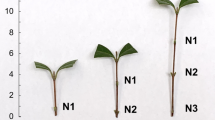Abstract
The vegetative propagation of the multipurpose leguminous shrub Colutea arborescens from leafless hardwood cuttings was examined. Specific attention was paid to the factors: 1) cutting origin (apical, medial or basal); 2) indole-3-butyric acid (IBA) treatment (0, 50 or 200 ppm); and 3) relative humidity of the propagation environment (high or low humidity). After 120 days, 67.6% of the C. arborescens cuttings had rooted. The rooting ability of the cuttings was significantly influenced by the cutting origin and hormonal treatment. No effects on rooting percentage were shown by the relative humidity of the propagation environment. The best rooting response (95%) was shown by basal cuttings treated with 200 ppm IBA. Cutting origin, IBA treatment and relative humidity were significantly related to the root number, longest root length and the fresh/dry biomass of roots and leaves. Under conditions of high humidity, basal cuttings treated with 200 ppm IBA gave rise to the most highly developed plants. The positive relationship between sprouting and rooting suggests that successful propagation is related to the shoot formation potential of the cutting's food reserves. These findings were used to propose an efficient method for the vegetative propagation of C. arborescens plants.
Similar content being viewed by others
References
Alegre J, Sancha JL, Guia E and Agudo MA (1993) Caracterización nutritiva de arbustos forrajeros: I. Composición química de leguminosas arbustivas y su evolución estacional. In: Gallego L and Pérez JI (eds) Producción Ovina y Caprina. XVIII Jornadas Científicas de la SEOC. Colección Estudios no 21. Univ Castilla-La Mancha. Albacete, Spain
Alegre J, Toledo JL, Martínez A, Mora O and de Andrés EF (1998) Rooting ability of Dorycnium spp. under different conditions. Scientia Horticulturae 76: 123-129
Allue JL (1982) Aspectos ecológicos, fenológicos y biométricos de Colutea arborescens L. Anales del INIA/Serie: Forestal 7: 111-128
Aminah H, Dick JMcP and Grace J (1997) Rooting of Shorea leprosula stem cuttings decreases with increasing leaf area. Forest Ecology and Management 91: 247-254
Aminah H, Dick JMcP, Leakey RRB, Grace J and Smith RI (1995) Effect of indole butyric acid (IBA) on stem cuttings of Shorea leprosula. Forest Ecology and Management 72: 199-206
Basak UC, Das AB and Das P (1995) Metabolic changes during rooting in stem cuttings of five mangrove species. Plant Growth Regulation 17: 141-148
de Andrés EF, Tenorio JL, Manzanares M, Sánchez FJ and Ayerbe L (1997) Mecanismos de resistencia a la sequía en leguminosas arbustivas. In: 3er Simposium Hispano-Portugués de Relaciones Hídricas en las Plantas, pp 5-8. IRTA, Sitges, Spain
Dick JMcP, McBeath C, Bisset H and Pottinger A (1996) Rooting ability of Calliandra calothyrsus leafy stem cuttings in a non-mist propagator. Agroforestry Systems 33: 187-193
Duncan DB (1955) Multi Range and Multi F Tests. Biometrics 11: 1-42
Grosvenor PW and Gray DO (1996) Colutequinone and colutehydroquinone, antifungal isoflavonoids from Colutea arborescens. Phytochemistry 43: 377-380
Hartmann HT, Kester DE and Davies FT (1990) Plant Propagation: Principles and Practices. 5th ed. Prentice-Hall publishers, Englewood Cliff, NJ, USA, 647 pp
Jinks RL (1995) The effects of propagation environment on the rooting of leafy cuttings of ash (Fraxinus excelsior L.), sycamore (Acer pseuodoplatanus L.), and sweet chestnut (Castanea sativa Mill.). New Forests 10: 183-195
Leakey RRB, Newton AC and Dick JMcP (1994) Capture of genetic variation by vegetative propagation: processes determining success. In: Leakey RRB and Newton AC (eds) Tropical Trees: the Potential for Domestication and the Rebuilding of Forest Resources, pp 72-83. HMSO, London, UK
Monteuuis O, Vallauri D, Poupard C and Chauvière M (1995) Rooting Acacia mangium cuttings of different physiological age with reference to leaf morphology as a phase change marker. Silvae Genetica 44: 150-154
Newton AC, and Jones AC (1993a) Characterization of microclimate in mist and non-mist propagation systems. Journal of Horticultural Science 68: 421-430
Newton AC, and Jones AC (1993b) The water status of leafy cuttings of four tropical tree species in mist and non-mist propagation systems. Journal of Horticultural Science 68: 653-663
Nickell LG (1982) Plant Growth Regulators: Agricultural Uses. Springer-Verlag, Berlin, Germany, 173 pp
Okoro OO and Grace J (1976) The physiology of rooting Populus cuttings. I. Carbohydrates and photosynthesis. Physiologia Plantarum 36: 133-138
Palanisamy K and Kumar P (1997) Effect of position, size of cuttings and environmental factors on adventitious rooting in neem (Azadirachta indica A. Juss). Forest Ecology and Management 98: 277-288
Papanastasis VP, Platis PD and Dini-Papanastasi O (1997) Productivity of deciduous woody an fodder species in relation to air temperature and precipitation in a Mediterranean environment. Agroforestry Systems 37: 187-198
Poupard C, Chauvière M and Monteuuis O (1994) Rooting Acacia mangium cuttings: effects of age, within-shoot position and auxin treatment. Silvae Genetica 43: 226-231
Sancha JL, Alegre J, Guerrero A and Yébenes L (1993) Caracterización nutritiva de arbustos forrajeros: II. Digestibilidad e ingestión. In: Gallego L and Pérez JI (eds) Producción Ovina y Caprina. XVIII Jornadas Científicas de la SEOC. Colección Estudios no 21. Univ Castilla-La Mancha. Albacete, Spain
SAS Institute Inc. (1988) SAS/STAT User's Guide. SAS Institute Inc., Ed., Cary, NC, 620 pp
Snedecor GW and Cochran WG (1957) Méthodes Statisques. Ed. A.C.T.A. Paris, France, 649 pp
Wiesmann Z and Lavee S (1995a) Relationship of carbohydrate sources and indole-3-butyric acid in olive cuttings. Australian Journal of Plant Physiology 22: 811-816
Wiesmann Z and Lavee S (1995b) Enhancement IBA stimulatory effect on rooting of olive cultivar stem cuttings. Scientia Horticulturae 62: 189-198
Zulueta J (1982) Efectos del recepe (corta) a tres alturas diferentes en plantas de Colutea arborescens L. Anales del INIA/Serie: Forestal 7: 99-110
Author information
Authors and Affiliations
Corresponding author
Rights and permissions
About this article
Cite this article
de Andres, E.F., Alegre, J., Tenorio, J.L. et al. Vegetative propagation of Colutea arborescens L., a multipurpose leguminous shrub of semiarid climates. Agroforestry Systems 46, 113–121 (1999). https://doi.org/10.1023/A:1006234909144
Issue Date:
DOI: https://doi.org/10.1023/A:1006234909144




